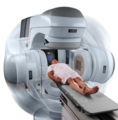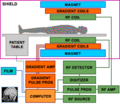Electromagnetic force
NOT ENOUGH MENTION OF IMPORTANCE IN MEDICINE: ALL MOLECULAR BONDING (YES EM FORCES HOLD YOUR BODY TOGETHER!, CHEMICAL ENEERGY IS ELECTROMAGENTIC), ELECTROMAGNETIC SPECTRUM (EVERY PART OF WHICH HAS APPLICATIONS IN MEDICINE)......
Electromagnetic forces
Introduction[edit | edit source]
Electromagnetic force is a special force that affects everything in the universe because it has an infinite-range attractive, like gravity; it is also a repulsive force which acts between charged particles. There are 4 fundamental forces in the universe; gravity, electromagnetism, strong nuclear force, and weak nuclear force. To start off, gravity is an attractive force between all matter, operates along all size scales but it dominates at the very large scale. Electromagnetism runs the same way, it operates along all size scales but it dominates at our scale; the human scale. So we essentially do live in an electromagnetic world. The particle that is used by electromagnetic forces are photons which have a strength of 1/137, a mass of 0 and a spin of 1 To look at electromagnetic forces, we can look at the charges. If we have a positive and a negative electric charge, it will result in attraction. If the electrical charges are the same, it will result in repulsion between the two. Another component of electromagnetic force is magnetic forces, if we have two magnetic dipoles, there is going to be attraction between the north and the south. The larger the magnet, the greater that force is going to be. Although magnets are different from electrical charges in that they don’t exist as a discrete north and south, there are still connections between electric charges and magnets. A charge can be generated if magnets are moved, and a magnetic field can be generated if a charge is moved, so essentially they are both the same thing. They also operate along all scales; however they dominate at the human scale. Electromagnetism is really one force; we can take charges as a proof. If we run charges (current) through a wire, and wrap it around a metal, which is not normally magnetic, it will generate a magnetic field and we’ve created something called an electromagnet. So a moving charge can create a magnetic field. We can take this electromagnet and spin it in a generator and we will generate current. A way to look at on how we can quantify those charges is Coulomb's law. So if we have two positive charges, there will be repulsion. If we have two opposite charges, there will be an attractive force. We can use Coulomb’s constant 9.0x109 N.(m/C)2 to figure out how great that force is going to be. Henceforth the bigger the charge the greater the repulsion or attraction is going to be (and the same applies to a magnet).
Medical importances[edit | edit source]
Radiation therapy utilises X-Rays, Gamma Rays or particles (such as protons or neutrons) that are highly penetrating used to target cancer cells, by targeting the affected area with the highly penetraing ratiation. In order to acheive a high penetrating power, a particle accelerators must be used. Examples of such particle accelerators are the Clinac 2100 accelerator and the Cobalt 600 accelerator. Radiation therapy is fact acting and has relatively low side effects compared to other, more modern techniques; however side effects should still be taken into consideration before use; side effects such as diarrhea, hair loss, fatigue, nausea/vomiting, throat, urinary and skin changes and so on. There are different types of treatments like external beam radiotherapy, proton therapy, x-rays, and gamma rays. This type of therapy is used in radiation and oncology. This use of electromagnetism is still used nowadays.
MRI scanning uses magnetism, radio waves, and a computer to produce images of body structures. Scanning is painless and does not involve x-ray radiation. It uses protons which are abundant in the human body. All protons spin creating a small magnetic charge, when a small magnetic field is introduced, as is the case in an MRI machine, the proton aligns with that field. The MRI technician then introduces a radio frequency pulse that disrupts the protons and forces it into a different alignment direction. Since the radio frequency fields push the proton against its nature, once this pulse is turned off, the protons realign with the magnetic field releasing electromagnetic energy along the way. The MRI is able to detect this energy and is able to differentiate the different tissues based on how quickly they release energy after the pulse is turned off. This use of electromagnetism is still used nowadays.
Aside from these examples, there are other various uses of electromagnetic forces: Mass spectrometry, Nuclear Magnetic Resonance (NMR), Cyclotrons and Cathod ray tubes.
Advantages and disadvantages[edit | edit source]
Electromagnetism is used in energy production (electromagnetic energy), and as always energy production has its advantages and disadvantages.
Advantages
Electromagnetic forces can be used for various applications, it is very versatile; there are a plethora of ways to utilise electromagnetic forces and energy, from small scale uses e.g microchips to larger scale and life saving uses e.g radiotherapy. It is clean energy, unlike oil and coal. As electrons (and photons) are abundant, there is no need to demolish the environment. In addition, this is a renewable source of energy as there will never be a shortage of electrons or magnetism. There are no radioactive or dangerous components required which can cause catastrophic danger to the environment or life.
Disadvantages
Although it Electromagnetic forces and energy has many advantages, it has several downsides. It is not as efficient as producing energy as hydrocarbons are. In additon, energy is wasted as there is electrical resistance, causing heat to be generated and lost. Electromagnetic radiation on the other hand has a handful of disadvantages; most radioisotopes have a short half life, so they are required to be used quickly; as a consequence, and because they are not that abundant, they are expensive. Also the radioisotopes need to be handled with care as they can be harmful.
Conclusion[edit | edit source]
In this current period of time, electromagnetic power is wasted. Only a miniscule percentage of electromagnetic signals are received by receivers, the rest of the signals are in the air. There are many uses for electromagnetics but there is so much more humanity can unlock and utilise. For instance, the waste electromagnetic power in the air is enough to power a phone or a large handheld device. The waste energy can be harnessed for more useful uses. The efficiency is also very low when generating the electromagnetic power, this can be dramatically reduced in the future by advancement in technology. The use for electromagnets is evergrowing and can potentially be used for complex mechanisms such as flying carrier and fighter jets; and perhaps in the not too distant future, be used to carry out everyday requirements for human life.
References[edit | edit source]
[1] http://emandpplabs.nscee.edu/cool/temporary/doors/forces/electromagforce/electromagnetic.htm
[2] http://agni.phys.iit.edu/~vpa/medical%20applications.htm
[3] http://science.howstuffworks.com/mri.htm
[4] http://physics.info/lorentz/
[5] http://www.ehow.co.uk/list_6779004_advantages-electromagnetic-energy-power-sources_.html


